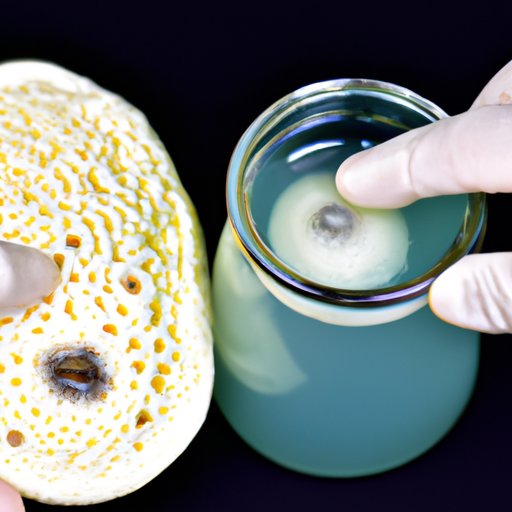
I. Introduction
Methicillin-resistant Staphylococcus aureus, or MRSA, is a serious and potentially life-threatening bacterial infection that is notoriously difficult to treat. In recent years, the incidence of MRSA has been on the rise, and it has become a major public health concern worldwide. This article aims to provide readers with a step-by-step guide on how to treat MRSA, including conventional and natural remedies. Additionally, it will explore the science behind MRSA and its treatment, offer a patient’s perspective, and emphasize the importance of taking this infection seriously.
II. A Step-by-Step Guide on How to Treat MRSA
MRSA is a type of staph infection that has become resistant to certain antibiotics. It is usually spread through skin-to-skin contact and can cause a wide range of symptoms, from mild skin infections to severe bloodstream infections. If you suspect that you have MRSA, it is important to seek medical attention right away to receive a proper diagnosis and treatment plan.
Conventional treatments for MRSA usually involve a combination of antibiotics, antiseptics, and drainage of any abscesses or infected tissue. In many cases, oral antibiotics are prescribed, such as trimethoprim-sulfamethoxazole, clindamycin, or linezolid. However, treatment may need to be tailored to the specific strain of MRSA and the severity of the infection.
While conventional treatments can be effective, they do come with potential risks and side effects. Antibiotic resistance is becoming a growing concern and may limit the effectiveness of these drugs over time. Additionally, some patients may experience adverse reactions to antibiotics, such as nausea, vomiting, or diarrhea. It is important to discuss all potential risks and benefits with your healthcare provider.
Alternative therapies for MRSA have been explored, including tea tree oil, colloidal silver, and manuka honey. While some of these remedies may have antibacterial properties, they are not typically considered a substitute for conventional treatment. It is important to avoid using any unproven or unsafe remedies without consulting a healthcare provider first.
Overall, it is crucial to follow any treatment plan as prescribed and finish the full course of antibiotics, even if symptoms improve before the medication is gone. Stopping antibiotics prematurely can promote the growth of antibiotic-resistant bacteria and make future infections more difficult to treat.
III. A Patient’s Perspective on Treating MRSA
It can be helpful to hear from someone who has gone through the experience of having MRSA. One patient shared their story of symptoms, diagnosis, and treatment experience. They stressed the importance of seeking medical attention as soon as possible and following the prescribed treatment plan closely. Coping with MRSA can also be emotionally challenging, and it can be helpful to seek support from loved ones and healthcare professionals.
IV. The Science Behind MRSA and Its Treatment
MRSA is caused by a strain of the Staphylococcus aureus bacteria that has developed a resistance to certain antibiotics, such as penicillin and methicillin. This happens through the acquisition of a gene known as mecA, which produces a protein that alters the bacterial cell wall and prevents antibiotics from working properly. MRSA can spread from person to person through physical contact or through contaminated surfaces, such as towels or equipment in a healthcare setting.
Prevention of MRSA can include good hygiene practices, such as handwashing, cleaning and covering wounds, and avoiding sharing personal items with others. Additionally, certain populations may benefit from screening and isolation precautions to reduce the spread of MRSA.
The treatment of MRSA can be challenging due to the resistance of the bacteria to many antibiotics. Recent studies have shown that some drugs, such as trimethoprim-sulfamethoxazole, clindamycin, and linezolid, may be more effective than others. However, the emergence of new strains of MRSA and the high cost of some drugs can present further challenges in treatment. Some promising future treatments include new vaccines or phages (viruses that infect bacteria and can be used to target specific strains of MRSA).
V. A Guide to Natural Remedies for MRSA
There are some natural remedies that have been found to have antibacterial activity against MRSA, such as garlic, honey, and propolis. While these remedies may be beneficial, it is important to note that they have not been extensively studied and are not a substitute for conventional treatment. It is always important to discuss any interest in using natural remedies with a healthcare provider, as they may have potential side effects or interactions with other medications.
VI. The Dangers of MRSA and Why It’s Important to Treat It
MRSA can cause serious and potentially fatal infections, such as pneumonia, sepsis, or necrotizing fasciitis. It is important to take MRSA seriously and seek medical attention promptly if you suspect you may have an infection. Prevention measures, such as good hygiene and screening for high-risk populations, are also important to reduce the spread of MRSA.
By following a proper treatment plan, discussing any interest in natural remedies with a healthcare provider, and taking prevention measures seriously, we can help to reduce the incidence and severity of MRSA infections.





